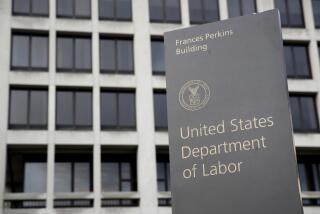25.6% of U.S. households use conventional banks little or not at all
More than a quarter of American households have limited or no interaction with conventional banks, making it more difficult for those families to establish credit, according to the first-ever federal survey of how consumers use financial services.
The survey, released Wednesday, found that 25.6% of households -- 30 million in all -- did not use basic banking services last year or relied on alternative services, such as high- interest payday loans, to get needed cash.
Those so-called unbanked and underbanked Americans are disproportionally low-income and minority families, including more than half of black households, according to the Federal Deposit Insurance Corp. survey.
The greater Los Angeles-Orange County area had patterns that were similar to the national results. The Census Bureau, on behalf of the FDIC, conducted the survey in January to cover data at the national, regional, state and metropolitan levels.
Many households seemed to have made a conscious choice to shun conventional financial services, FDIC Chairwoman Sheila C. Bair said.
But households without bank accounts could be more vulnerable to loss or theft and less able to build a credit profile or reach financial security, the report said. Households that rely mainly on services such as payday loans or overdraft programs are often hit with enormous fees and interest rates.
“Access to an account at a federally insured institution provides households with an important first step toward achieving financial security -- the opportunity to conduct basic financial transactions, save for emergency and long-term security needs and access credit on affordable terms,” Bair said.
Nationally, 7.7% of households, or 9 million, had no checking or savings accounts. More than 41% of those families said opening a future account was “not likely at all.” Roughly half of unbanked households previously had accounts.
Households considered underbanked -- about 17.9%, or 21 million -- relied on other nonbank services, such as money orders, check cashing or pawn shops, while also holding some combination of checking and savings accounts.
“Stubborn infrastructure” at financial institutions, as well as the cost and range of their services, are to blame for the high rate of unbanked and underbanked consumers, said Red Gillen, senior analyst at Celent, a Boston financial research and consulting firm.
“Age, ethnicity and geographic differences within this group mean that financial service firms will have to pursue a sophisticated marketing strategy, and a one-size-fits-all marketing strategy simply will not work,” he said.
Minority groups were less likely than the overall population to have standard banking relationships.
Nearly 22% of black households were unbanked, as well as 19.3% of Latino households and 15.6% of Native American households. Just 3.5% of Asians and 3.3% of whites did not use banking services.
The survey found that those considered underbanked included 31.6% of black households, 28.9% of Native Americans and 24% of Latinos. Only 7.2% of Asian households and 14.9% of whites were underbanked.
Many Latinos are most comfortable operating in cash, said James Gutierrez, chief executive of Progreso Financiero in Mountain View, Calif., which focuses on giving small, short-term loans to Latinos. Instead of having a paycheck put on hold for several days at a bank, many turn to expensive payday loans for immediate liquidity.
“There’s a lot of distrust of banks,” Gutierrez said. “But even though it’s convenient for them to operate outside the financial mainstream, they can’t build a credit history, get a small-business loan, build wealth. You need to give people a staircase upwards.”
Nearly three-quarters of households without bank accounts had annual incomes under $30,000, amounting to about a fifth of those in that income bracket. But only 4.2% of households earning $30,000 to $50,000, and less than 1% of those making $75,000 or more, were unbanked.
Last year, 1.2 million U.S. households stopped holding bank accounts. Of households that had previously banked, more than 31% blamed high minimum balance limits, overdraft fees and service charges for causing them to leave the system, while 34% said they did not have the funds to justify an account, the survey found.
Others said they preferred the convenience, speed and cost of check cashing and money orders at nonbanks.
FDIC Vice Chairman Martin J. Gruenberg urged banks to offer affordable, straightforward products, such as savings accounts and small loans, for low-income consumers.
“The key issue is access to financial services that are low-cost and offered on a responsible basis for people,” he said. “It’s important for banks to compete for this market.”
In the greater Los Angeles-O.C. area, 9.2% of the 4.4 million households were unbanked and 14.4% were underbanked, according to the survey.
Of the 406,000 unbanked households in the region, 23.3% had incomes of $30,000 or less. More than 18% were Latino and 17.8% were black. Of the area’s 637,000 underbanked households, nearly 20% had incomes of $30,000 or less; 32.3% were black and 21.2% were Latino.







